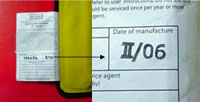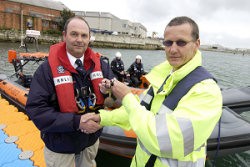Issue Ten, Summer 2008.
Page 6
Scran bag!!
Page 1 Sailing in Africa Sailing in Africa II Owners Tips Therapist
This page will be a collection of snippets and information, gleaned from owners and friends, newspapers, magazines and scurrilous here-say as well no doubt, hopefully all factual, as far as can be ascertained, and maybe humorous, we all need a giggle some times! Have you found a snippet we could add?
|
|
|||
This one is a year old, but still valid. Watch out for it on the Crouch.
|
Huge marine wetland starts life
|
||||
A 300m section of a sea wall has been breached to begin the creation of the UK's largest man-made marine wetland. Almost 115 hectares has been flooded at Wallasea Island, Essex, to create wetland, mudflats, saline lagoons and seven artificial islands. The £7.5m government-funded project aims to replace bird habitats lost to development, improve flood defences, and create leisure opportunities. Excavators were used to breach the sea wall on Tuesday to allow the sea in.
Mark Dixon, who is managing the Wallasea Wetlands Creation project, said the tide spread across land that was once wheat fields and it began the slow process of creating new salt marsh and mudflats. He said: "It's eventually going to be a new sea defence, so you're going to have brand new mudflats, brand new salt marshes and they'll absorb the tide's energy. "You've got a big new sea wall at the back, protecting land and property, and then in front of it a series of lagoons and islands and creeks, which birds and people can enjoy."
Biodiversity Minister Barry Gardiner said: "Salt marsh is more rare than rainforest, and is important to people, particularly as a flood and storm defence, and to wildlife. "Hundreds of thousands of wetland birds rely entirely on the Essex salt marsh for their food each winter. "Wallasea Wetlands will be a wonderful feeding and roosting habitat for birds like oystercatchers, avocets and little terns, which have been gradually displaced from the area during the last 50 years, as well as creating a haven for other rare wildlife." It is hoped the wetland will also provide for better fish nurseries. John Hesp, of Wallasea Farms, said the flooding would help improve the area's flood defences. He said: "What we're doing here by setting the seawalls back - we call the process managed re-alignment, is that the existing seawalls were in such poor condition, they were simply not sustainable in their present location. "We've built a new seawall landward and now that we've breached, we've breached at the points where we have the maximum pressure on the estuary. "So, we've relieved that pressure, enabled the estuary to breathe and we've created more space for water."
|
||||
I was browsing an old copy of PBO today and found this, could not resist it!
I think Mike Petyon would not mind!
From various internet searches and discussion forums the commodore of Bradwell Cruising Club have gleamed the following:
The lock gates were broken last December and are
going to be fixed some time.
There is a sill fitted to maintain the water level in the marina but the
retained water level is about 2 - 3 metres lower than when the lock gates
were in use.
There are 2 extra bridge opening + & - 3 hours HW but check the sill height. The first and last will be suitable for smaller boats. Large illuminated depth gauge on both sides.
The normal visitors pontoon has around 1m of depth next to it but this
increase as you raft out. The bottom is soft mud.
There are plans to fit a new pontoon further out to give 2 - 3 metre of
water for the summer. Do not know if this will be in place for end of May.
Please make you own check for updated information on entrance to Calais. Above is for information only and no responsibility can be taken by the RNSA or it author for how correct, complete the data is.
This is useful info.....
CROSSING THE ENGLISH CHANNEL / DOVER STRAIT
A Voluntary Separation Scheme (VSS) is in use to help ferries safely cross the Dover TSS. It is not a formal Separation Scheme and is not shown on official charts, but small craft should be aware of its existence. Most cross-Channel ferries can be expected to be using the VSS but high speed ferries are not included in the scheme. The VSS is bounded by the following points:
1) 51°05·35N 01°28·00E
2) 51°00·10N 01°40·00E
3) 50°59·30N 01°39·10E
4) 51°04·70N 01°26·80E
A separation line extends from a point midway between points 2 and 3 above to 1M W of CA6 buoy. Parallel to and 1·5M to the NE of this zone a further separation line extends from 51°06·40N 01°29·90E to 51°01·20N 01°41·60E. Calais to Dover ferries keep to the W of this line; ferries to and from Dover and Dunkerque keep to the E.
Seago Lifejacket Recall.
found by John Stevens.
|
Thanks again to John Stevens for spotting this. Be aware of the radio mike at all times....
Helicopter scrambled to stop ch16 broadcast
 A helicopter had to be scrambled to stop a yacht in the English Channel from
broadcasting on VHF Channel 16 on Sunday.
A helicopter had to be scrambled to stop a yacht in the English Channel from
broadcasting on VHF Channel 16 on Sunday.
The yacht was unknowingly broadcasting continuously on VHF Channel 16,
effectively jamming all emergency communications in mid Channel and
affecting the ability of Portland Coastguard, Brixham Coastguard, Solent
Coastguard, CROSS Jobourg (France) and Guernsey Coastguard to handle
emergency traffic.
The approximate position of the yacht was found from Direction Finding
bearings from both sides of the Channel. After an hour of jamming and
attempts to contact the vessel, Portland Coastguard scrambled the Coastguard
Helicopter 106 to find the yacht using its on-board direction finding
equipment. The helicopter circled the yacht, attracted the skipper's
attention and eventually was able to make contact to stop him broadcasting
on Channel 16.
Nic Lonsdale, Watch Officer at Portland Coastguard said "It is not only
irritating to have the Maritime Distress Channel blocked, by what the yacht
crew thought was a private conversation, but a danger to all other vessels.
Eventually, we were forced to deploy a helicopter to silence the
transmissions. Shortly afterwards a different vessel broadcast a Mayday,
which would not have been heard had the yacht still been transmitting. All
users are urged to be aware of this increasingly common problem. If you
cannot hear any radio traffic in a busy area it is probably because you are
continuously transmitting."
Details of the incident have been passed to the Maritime and Coastguard
Agency Enforcement Branch.
Yachting Monthly, 1 July 2008
|




 Seago Yachting has released a statement saying that some Seago
150 and 175 Newton Lifejackets, including Junior Lifejackets,
may have a defect which could result in serious injury.
Seago Yachting has released a statement saying that some Seago
150 and 175 Newton Lifejackets, including Junior Lifejackets,
may have a defect which could result in serious injury. 